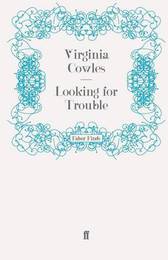
|
Looking for Trouble
Paperback
Main Details
| Title |
Looking for Trouble
|
| Authors and Contributors |
By (author) Virginia Cowles
|
| Physical Properties |
| Format:Paperback | | Pages:480 | | Dimensions(mm): Height 216,Width 135 |
|
| Category/Genre | History |
|---|
| ISBN/Barcode |
9780571270910
|
| Classifications | Dewey:070.92 |
|---|
| Audience | |
|---|
| Edition |
Main
|
|
Publishing Details |
| Publisher |
Faber & Faber
|
| Imprint |
Faber & Faber
|
| Publication Date |
20 May 2010 |
| Publication Country |
United Kingdom
|
Description
First published in June 1941, Looking for Trouble is the tour de force testimony of an American debutante who became a roving war correspondent noted for her bravery and perceptiveness. 'Virginia Cowles went looking for trouble, and did she find it... While covering the Spanish Civil War, she had only to arrive in Valencia for the first bombs to fall there... Attending the 1938 party congress in Nuremberg, she was terrified by the frenzy of adulation for Hitler.' Daily Mail 'She was in Berlin the day Germany launched its attack on Poland, in Helsinki as the Russians invaded Finland, and she reached Paris when the Germans were just 17 miles from the city... It was war reporting of a long gone era, when journalists were not embedded but ranged freely... Looking for Trouble is a reminder of how excellent a reporter [Cowles] was.' Caroline Moorhead, Spectator
Author Biography
Virginia Cowles (1910-1983) was an author and journalist. Born in Vermont, USA she became a well-known journalist in the 1930s with her columns appearing on both sides of the Atlantic. Her autobiography, Looking for Trouble (Faber Finds) covers with brio her reporting of the main events between 1935 and 1940. During the Second World War she covered the Italian campaign, the liberation of Paris, and the Allied invasion of Germany. In 1945 she married the politician and writer Aidan Crawley. She wrote many biographies including Winston Churchill; the Era and the Man and Edward V11 and His Circle. In his memorial address, Nigel Nicolson recalled the first time he met her, 'her appearance was doubly startling: that she should be there at all at so critical a moment; and that she was the most beautiful young woman on whom, until then, I had ever set my eyes.'
|